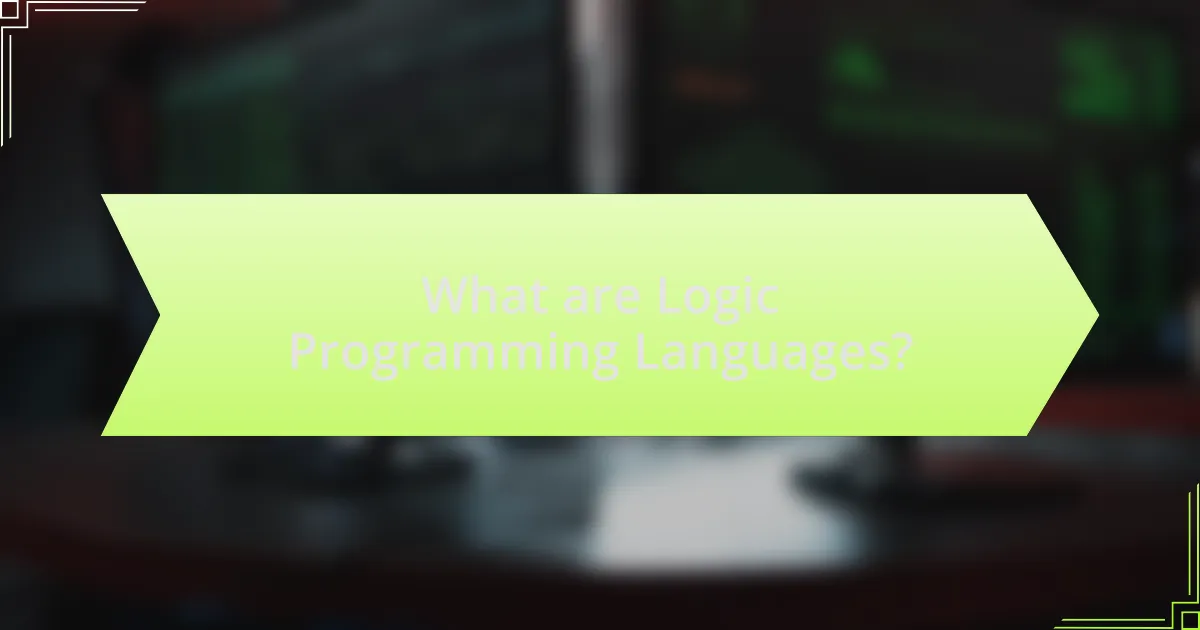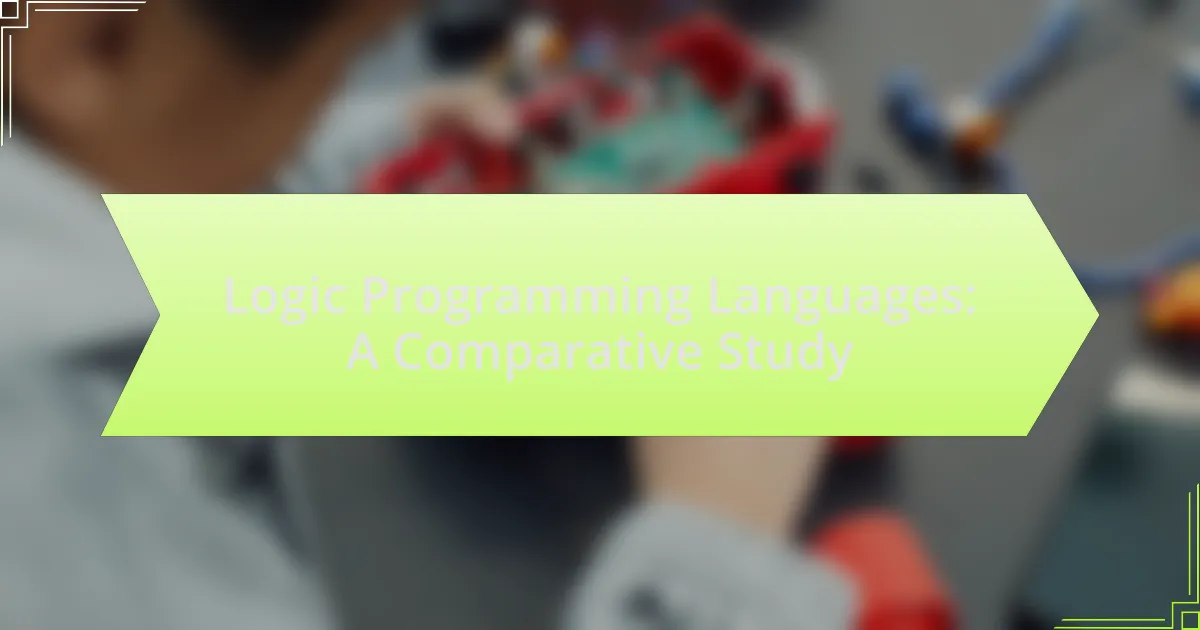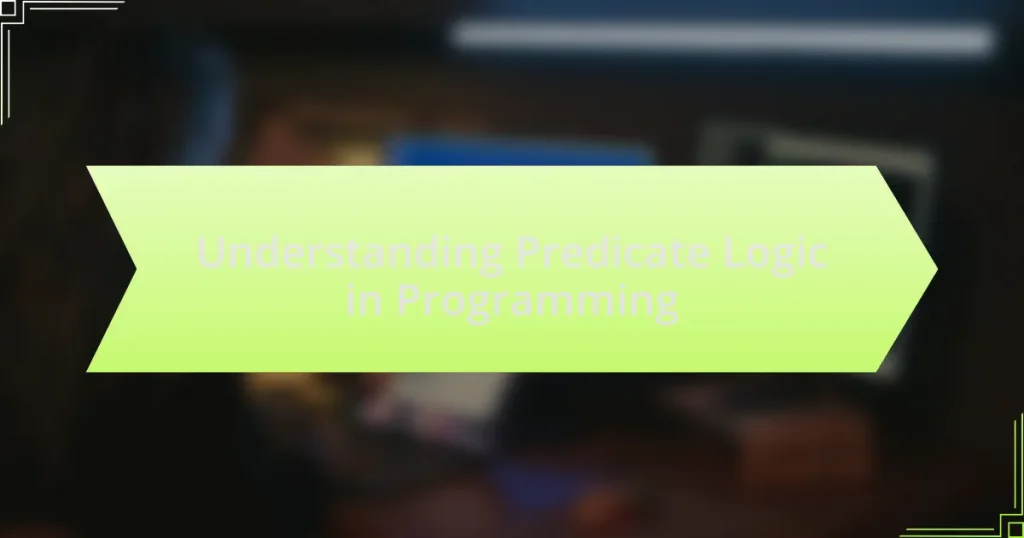Logic programming languages, such as Prolog, Mercury, and Datalog, utilize formal logic to express computations through predicates and rules, enabling systems to infer conclusions from facts. This article provides a comprehensive overview of logic programming languages, highlighting their fundamental principles, key features, and differences from other programming paradigms. It explores how these languages handle data and logic, their applications in artificial intelligence and database management, and the strengths and weaknesses of Prolog as a prominent example. Additionally, the article addresses challenges faced by users, best practices for optimization, and available resources for learning these languages, offering a detailed comparative study of their effectiveness in various real-world scenarios.

What are Logic Programming Languages?
Logic programming languages are a category of programming languages that use formal logic as a basis for expressing computations. These languages, such as Prolog, allow programmers to define relationships and rules, enabling the system to infer conclusions from given facts. The foundational principle of logic programming is the use of predicates and logical statements to represent knowledge, which the interpreter uses to derive answers through a process called resolution. This approach contrasts with imperative programming, where the focus is on how to perform tasks rather than what the tasks are. Logic programming languages are particularly effective in fields such as artificial intelligence and computational linguistics, where reasoning and knowledge representation are crucial.
How do Logic Programming Languages differ from other programming paradigms?
Logic programming languages differ from other programming paradigms primarily in their approach to problem-solving, which is based on formal logic rather than procedural or object-oriented methods. In logic programming, such as in Prolog, the programmer specifies a set of facts and rules, and the language’s inference engine derives conclusions or solutions through logical reasoning. This contrasts with imperative programming, where the focus is on explicitly detailing the steps to achieve a result, and object-oriented programming, which centers around encapsulating data and behavior within objects. The unique characteristic of logic programming is its declarative nature, allowing programmers to express what the program should accomplish without dictating how to achieve it, thus facilitating a different style of reasoning and problem-solving.
What are the fundamental principles of Logic Programming?
The fundamental principles of Logic Programming include the use of formal logic as a programming paradigm, where programs are expressed in terms of relations and rules rather than explicit control flow. Logic Programming relies on a declarative approach, allowing the programmer to specify what the program should accomplish without detailing how to achieve it.
Key components of Logic Programming are facts, rules, and queries. Facts represent basic assertions about the world, rules define relationships between facts, and queries allow for the retrieval of information based on these facts and rules. The execution model is based on resolution and unification, which are processes used to derive conclusions from the given facts and rules.
These principles are validated by the success of Logic Programming languages like Prolog, which has been widely used in artificial intelligence and computational linguistics, demonstrating the effectiveness of this paradigm in solving complex problems through logical inference.
How do Logic Programming Languages handle data and logic?
Logic programming languages handle data and logic through a declarative paradigm, where programs consist of a set of facts and rules that describe relationships and constraints. In this paradigm, data is represented as logical statements, and logic is processed using inference mechanisms to derive conclusions or answer queries based on those statements. For example, Prolog, a prominent logic programming language, utilizes a resolution-based inference method to evaluate logical expressions and derive new information from existing facts. This approach allows for efficient problem-solving in domains such as artificial intelligence and database querying, where the focus is on what is true rather than how to compute it.
What are the key features of Logic Programming Languages?
Logic programming languages are characterized by their use of formal logic to express computations. The key features include declarative programming, where the programmer specifies what the program should accomplish rather than how to achieve it; the use of facts and rules to represent knowledge; and automatic backtracking, which allows the system to explore multiple possibilities to find solutions. Additionally, these languages often support unification, a process that determines when two terms can be considered identical, and they typically utilize a resolution-based inference mechanism for deriving conclusions from the given facts and rules. These features enable efficient problem-solving in domains such as artificial intelligence and database querying.
How do unification and backtracking work in Logic Programming?
Unification in logic programming is the process of making two terms identical by finding a substitution for their variables. This mechanism allows for the matching of predicates and terms in a logical expression, enabling the resolution of queries against a knowledge base. Backtracking, on the other hand, is a search strategy used to find solutions by exploring possible paths and reverting to previous states when a dead end is encountered. In logic programming, when a goal cannot be satisfied, the system backtracks to the last decision point to try alternative solutions. Together, unification and backtracking facilitate the execution of logical queries, allowing for the exploration of multiple potential solutions efficiently. This is evidenced by their implementation in Prolog, where these techniques are fundamental to the language’s operation, enabling it to solve complex problems through logical inference.
What role do predicates and clauses play in Logic Programming Languages?
Predicates and clauses are fundamental components of Logic Programming Languages, serving as the building blocks for expressing logical relationships and rules. Predicates represent properties or relations among entities, allowing for the formulation of statements that can be evaluated as true or false. Clauses, which are disjunctions of literals, typically express rules or facts in a logical framework, enabling the inference of new information based on existing knowledge.
For example, in Prolog, a widely used logic programming language, a clause might define a relationship such as “parent(X, Y) :- mother(X, Y).” This clause indicates that X is a parent of Y if X is a mother of Y, demonstrating how predicates and clauses work together to facilitate logical reasoning and query answering. The use of predicates and clauses allows for a declarative programming style, where the focus is on what the program should accomplish rather than how to achieve it, thus enhancing the expressiveness and efficiency of logic programming.

What are the most popular Logic Programming Languages?
The most popular logic programming languages include Prolog, Mercury, and Datalog. Prolog, developed in the 1970s, is widely recognized for its use in artificial intelligence and computational linguistics, boasting a rich ecosystem of libraries and tools. Mercury, introduced in the 1990s, enhances Prolog’s capabilities with strong typing and mode systems, making it suitable for large-scale applications. Datalog, a subset of Prolog, is primarily used in database queries and has gained traction in data analysis and knowledge representation. These languages are validated by their extensive use in academia and industry, with Prolog being a foundational language in AI research and Mercury being adopted in various software projects.
What are the characteristics of Prolog as a Logic Programming Language?
Prolog is characterized by its use of facts, rules, and queries to represent and manipulate knowledge. It operates on a declarative paradigm, allowing users to specify what the program should accomplish rather than how to achieve it. Prolog employs a resolution-based inference mechanism, which enables it to derive conclusions from the provided facts and rules through logical reasoning. Additionally, Prolog supports backtracking, allowing the system to explore multiple potential solutions and revert to previous states when necessary. These characteristics make Prolog particularly suitable for applications in artificial intelligence, natural language processing, and theorem proving, where logical relationships and knowledge representation are crucial.
How does Prolog implement logic and reasoning?
Prolog implements logic and reasoning through a declarative programming paradigm that utilizes facts, rules, and queries to derive conclusions. In Prolog, knowledge is represented as a series of facts (e.g., “sibling(john, mary).”) and rules (e.g., “sibling(X, Y) :- parent(Z, X), parent(Z, Y).”) that define relationships and logical implications. The Prolog interpreter uses a process called backtracking to search through these facts and rules to answer queries, effectively simulating logical reasoning by exploring possible solutions until it finds one that satisfies the conditions of the query. This method of resolution is grounded in first-order predicate logic, allowing Prolog to perform complex reasoning tasks efficiently.
What are the strengths and weaknesses of Prolog?
Prolog’s strengths include its powerful pattern matching and symbolic reasoning capabilities, which make it well-suited for tasks involving complex data relationships and artificial intelligence applications. Its declarative nature allows users to express logic without detailing control flow, simplifying problem-solving in domains like natural language processing and expert systems. Conversely, Prolog’s weaknesses lie in its performance limitations for large-scale applications and its steep learning curve for those unfamiliar with logic programming paradigms. Additionally, Prolog’s reliance on backtracking can lead to inefficiencies in certain computational scenarios, making it less suitable for tasks requiring high-performance computing.
What other Logic Programming Languages are notable?
Notable logic programming languages include Prolog, Mercury, and Datalog. Prolog, developed in the 1970s, is widely recognized for its use in artificial intelligence and computational linguistics. Mercury, introduced in the 1990s, emphasizes efficiency and is designed for real-world applications, offering strong typing and mode systems. Datalog, a subset of Prolog, is primarily used in databases and is known for its declarative nature, making it suitable for querying and reasoning about data. These languages have significantly contributed to the field of logic programming through their unique features and applications.
How does Mercury compare to Prolog in terms of performance?
Mercury generally outperforms Prolog in terms of execution speed and efficiency due to its strong typing and mode system, which allows for more optimized compilation. Specifically, Mercury’s design focuses on determinism and purity, enabling the compiler to generate more efficient code compared to Prolog’s more flexible but less optimized execution model. Studies have shown that Mercury can achieve performance improvements of up to several times faster than Prolog in certain benchmarks, particularly in computationally intensive tasks.
What unique features does Datalog offer in Logic Programming?
Datalog offers unique features in logic programming, primarily its declarative nature and its use of a subset of first-order logic. Datalog’s syntax is simpler than that of full Prolog, focusing on rules and facts without the complexities of variables and predicates that can lead to non-termination. Additionally, Datalog supports recursive queries, enabling efficient handling of hierarchical data structures, which is particularly useful in database applications. Its operational semantics are based on a bottom-up evaluation strategy, allowing for optimization techniques like magic sets and semi-naive evaluation, which enhance performance in large datasets. These features make Datalog particularly suited for applications in databases, knowledge representation, and data integration.

How do Logic Programming Languages apply in real-world scenarios?
Logic programming languages apply in real-world scenarios primarily through their use in artificial intelligence, database management, and natural language processing. For instance, Prolog, a prominent logic programming language, is utilized in AI for tasks such as theorem proving and expert systems, where it can efficiently handle complex queries and reasoning tasks. Additionally, logic programming is employed in database systems for query optimization and constraint satisfaction, allowing for more efficient data retrieval and manipulation. In natural language processing, logic programming facilitates the development of systems that can understand and generate human language by representing knowledge in a structured format. These applications demonstrate the practical utility of logic programming languages in solving real-world problems across various domains.
What industries utilize Logic Programming Languages effectively?
Logic programming languages are effectively utilized in industries such as artificial intelligence, natural language processing, and database management. In artificial intelligence, languages like Prolog are used for knowledge representation and reasoning, enabling systems to solve complex problems through logical inference. In natural language processing, logic programming facilitates the development of systems that understand and generate human language by modeling linguistic structures. Additionally, in database management, logic programming languages support query languages and data retrieval processes, enhancing the efficiency of information systems. These applications demonstrate the versatility and effectiveness of logic programming across various sectors.
How is Logic Programming used in artificial intelligence applications?
Logic programming is used in artificial intelligence applications primarily for knowledge representation and reasoning. This paradigm allows for the expression of facts and rules about problems within a formal system, enabling systems to infer conclusions from known information. For instance, Prolog, a prominent logic programming language, is widely utilized in AI for tasks such as natural language processing, expert systems, and automated theorem proving. The ability to represent complex relationships and perform logical deductions makes logic programming particularly effective in domains requiring structured reasoning, such as robotics and game playing.
What role does Logic Programming play in database management systems?
Logic programming plays a crucial role in database management systems by enabling declarative querying and reasoning about data. This paradigm allows users to specify what data they want to retrieve without detailing how to obtain it, which simplifies the interaction with databases. For instance, languages like Prolog utilize logic programming principles to facilitate complex queries and inferencing, making it easier to handle relationships and constraints within the data. The effectiveness of logic programming in databases is evidenced by its application in systems like Datalog, which is used for deductive databases, allowing for powerful data manipulation and retrieval capabilities.
What are the challenges faced when using Logic Programming Languages?
Logic programming languages face several challenges, including difficulty in debugging, performance issues, and limited support for certain programming paradigms. Debugging in logic programming can be complex due to the non-procedural nature of the languages, making it hard to trace the flow of execution. Performance issues arise because logic programming often relies on backtracking and unification, which can lead to inefficiencies in computation, especially for large datasets. Additionally, these languages may not support imperative or object-oriented paradigms effectively, limiting their applicability in certain software development contexts. These challenges highlight the need for careful consideration when choosing logic programming languages for specific applications.
How do performance issues affect the use of Logic Programming?
Performance issues significantly limit the effectiveness of Logic Programming by impacting execution speed and resource utilization. Logic Programming relies on backtracking and unification, which can lead to inefficiencies, especially in large datasets or complex queries. For instance, Prolog, a widely used Logic Programming language, can experience exponential time complexity in certain scenarios, making it unsuitable for real-time applications. Studies have shown that performance optimizations, such as indexing and constraint logic programming, can mitigate these issues, but they often require additional development effort and expertise. Consequently, performance concerns can deter developers from adopting Logic Programming for applications where speed and efficiency are critical.
What are common pitfalls for beginners in Logic Programming?
Common pitfalls for beginners in Logic Programming include misunderstanding the declarative nature of the paradigm, failing to grasp recursion and backtracking, and neglecting to utilize built-in predicates effectively. Beginners often approach Logic Programming with an imperative mindset, which leads to confusion about how to express logic and relationships rather than step-by-step instructions. Additionally, recursion is a fundamental concept that can be challenging, as it requires a different way of thinking about problem-solving. Backtracking, which is a key feature in many Logic Programming languages, can also be misinterpreted, leading to inefficient solutions. Lastly, beginners may overlook the power of built-in predicates, which can simplify code and enhance performance, resulting in unnecessarily complex implementations.
What best practices should be followed when working with Logic Programming Languages?
When working with Logic Programming Languages, it is essential to follow best practices such as clear predicate definition, effective use of recursion, and proper management of backtracking. Clear predicate definition ensures that the logic is easily understandable and maintainable, which is crucial for debugging and collaboration. Effective use of recursion allows for elegant solutions to problems that can be defined in terms of smaller subproblems, enhancing code efficiency and readability. Proper management of backtracking is vital to avoid excessive computation and to ensure that the program explores all possible solutions without unnecessary delays. These practices contribute to writing efficient, maintainable, and scalable logic programs.
How can one optimize Logic Programs for better performance?
To optimize Logic Programs for better performance, one can employ techniques such as indexing, tail recursion, and constraint propagation. Indexing improves the efficiency of data retrieval by creating data structures that allow for faster access to facts and rules. Tail recursion optimization reduces the overhead of recursive calls by reusing stack frames, which is particularly beneficial in programs with deep recursion. Constraint propagation enhances performance by reducing the search space in constraint logic programming, allowing for quicker resolution of queries. These methods have been validated through various studies, demonstrating significant performance improvements in logic programming environments. For instance, research has shown that indexing can reduce query time complexity from exponential to polynomial in certain scenarios, thereby confirming its effectiveness in optimizing logic programs.
What resources are available for learning Logic Programming Languages?
Resources available for learning Logic Programming Languages include online courses, textbooks, and academic papers. Online platforms such as Coursera and edX offer courses specifically focused on languages like Prolog and Mercury, providing structured learning paths. Textbooks such as “Programming in Prolog” by Clocksin and Mellish and “The Art of Prolog” by Sterling and Shapiro serve as comprehensive guides for understanding the principles and applications of logic programming. Additionally, academic papers and journals, such as the Journal of Logic Programming, provide insights into advanced topics and recent developments in the field. These resources collectively support learners in gaining both foundational and advanced knowledge in Logic Programming Languages.



